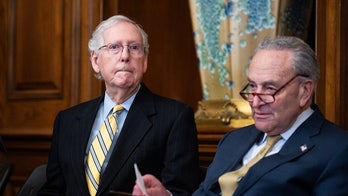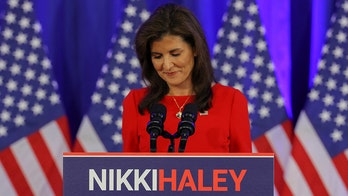Rpt: US blocks Arab allies from arming Kurds fighting ISIS
Allies ready to 'go it alone' in giving heavy weapons to Kurds in Iraq
The rise of global terrorism and the savagery committed by the Islamic State and Al Qaeda in parts of Yemen, Syria and Iraq has some counterterrorism experts questioning the Obama administration’s strategy of “light footprint” against the extremist movements.
Many have argued for deeper U.S. involvement in the hotly contested areas, if not with regular ground troops, then with at least elite military advisers. Some argue the template of training local forces and attacking terrorists from the air is actually making matters worse in the Middle East.
"What they are doing now is making it more likely that there will be a bigger, more disastrous catastrophe for the United States," said David Sedney, who resigned in 2013 as deputy assistant secretary of defense for Afghanistan and Pakistan.
"Drone strikes are not creating a safer, more stable world," Sedney said, and neither is the limited bombing campaign the Pentagon is running against the Islamic State group in Iraq and Syria. Both are creating new enemies, he added, without a plan to defeat them.
The New York Times reported Thursday that Islamic radical Seifallah Ben Hassine, founder of the Tunisian militant group Ansar al-Sharia, was killed in a U.S. airstrike in Libya last month. The Pentagon also announced Thursday Tariq bin Tahar al-'Awni al-Harzi, an ISIS leader who had facilitated suicide bombings, was killed by a U.S. drone strike.
His death will impact ISIL's ability to integrate foreign terrorist fighters into the Syrian and Iraqi fight," military spokesman Capt. Jeff Davis said.
Critics wonder could these drone strikes continue to be successful in killing top leaders of terror groups. Former Army deputy chief Lt. Gen. Richard Zahner says the Obama administration's policy of "benign neglect" toward strife-torn Yemen and Syria has ensured the existence of terrorist safe havens there for both Al Qaeda and ISIS militants.
Michele Flournoy, the former undersecretary of defense for policy who was the president’s first choice to replace Chuck Hagel as defense secretary, wrote last month criticizing the plan off attack against the Islamic State, saying it’s “faltering” and urged a more robust approach.
"U.S. counterterrorism policy has caused some intense backlash and has had a lot of unintended consequences," said Rosa Brooks, a former Obama administration Pentagon official.
Current officials have disputed experts’ criticism, but declined to make anyone available to comment. The White House’s position is that the failure of Al Qaeda or the Islamic state to launch a coordinated attack on the U.S. homeland is the best evidence that the strategy is working.
Timothy Hoyt, the professor of counterterrorism studies at the Naval War College, agreed. Terrorist attacks against the U.S. and its allies have been far less than lethal than past campaigns in Britain by the Irish Republican Army, he said, “which suggests that some elements of our counterterrorism strategy are working."
Hoyt said it is “absurd” to blame U.S. policy for an uptick in secretarian violence across a Middle East convulsed by political upheaval.
Drone strikes have clearly made it harder for terrorists to plan complex attacks, he said. While the strikes create international backlash, he added, there is no evidence they are a driving force in the growth of terror networks.
A task force at the Henry L. Stimson Center took a different view in April, raising questions about the long-term effects of killing terrorists with drones.
"We are concerned that the Obama administration's heavy reliance on targeted killings as a pillar of U.S. counterterrorism strategy rests on questionable assumptions, and risks increasing instability and escalating conflicts," concluded the task force, co-chaired by Brooks and retired Gen. John Abizaid.
The Wahishi operation underscored a little-understood trend of the drone war: “Most "high value targets" have been killed in what are known as signature strikes, in which a missile is aimed at a group of militants whose identities aren't confirmed until after they're dead, U.S. officials have said.
The CIA launched a drone strike last month on a Yemeni beach at three men it determined were Al Qaeda militants. One of them turned out to be Nasser al-Wahishi, second in command in Al Qaeda’s Yemen affiliate group.
The CIA didn't know at first that Wahishi was among the men it had targeted, said three U.S. officials, none of whom would be quoted by name discussing a covert operation.
The administration officials had once signaled they would be cutting back on signature strikes, which pose a higher risk of killing the wrong people, some of which include civilians. But the evacuation of the embassy in Yemen and the CIA’s absence in Syria mean such strikes wil more common, the U.S. officials said.
Drone strikes "do not defeat terrorist organizations," said Seth Jones, a counterterrorism analyst at the Rand Corp. think tank.
Yet many critics of Obama's approach are calling for a deeper American involvement against the Islamic State. Many military analysts, for example, say U.S. special operations troops should be allowed to direct air strikes and embed with local units on the Syrian and Iraqi battlefields, something they are not now doing. Others argue that U.S. should take military action to remove Syrian President Bashar Assad, a magnet for extremists who want to fight him.
The U.S. has resisted in doing so, citing lessons of Iraq and Afghanistan, where yearslong occupations failed to defeat extremists or instill stable democracies.
President Obama has acknowledged that the U.S. cannot kill its way to victory against terrorism, and has said his strategy also includes addressing poverty and political repression as well as training local military forces.
We need all elements of national power to win a battle of wills, a battle of ideas," the president said in June 2013.
But the U.S. so far has not proven adept at any of that, counterterrorism experts say.
The more hopeful case may be in Somalia, where U.S.-trained forces pushed the Al Qaead affiliate out of some territory it once held. But the group is still mounting lethal attacks on civilians.
In Afghanistan, the jury is still out on whether Afghan security forces can keep the Taliban from re-taking major cities. In Iraq and Syria, efforts to train forces capable of ousting the Islamic State group from its strongholds have ranged from slow to ineffectual.
In Yemen, the U.S. for a while had a sympathetic government that allowed American drone strikes while deploying its own U.S. trained troops to fight Al Qaeda. But a U.S. concentration on counterterrorism to the exclusion of political and social problems destabilized the country, Sedney and others argue, contributing to the government's fall.
The lesson of the 9/11 attacks, said Bruce Hoffman, a terrorism expert at Georgetown University, "was that these groups are the most dangerous when they have a sanctuary. The fact of the matter is they have far more sanctuary today than they had a decade and a half ago."
"It's dangerous," Hoffman added, "to wrap ourselves in this false security blanket that we've prevented them from attacking the U.S. thus far."
The Associated Press contributed to this report





